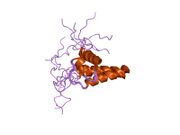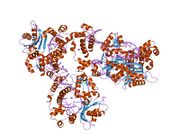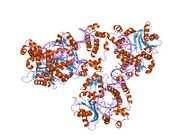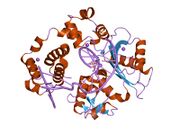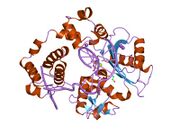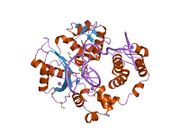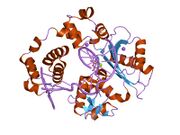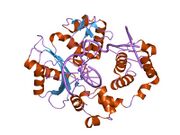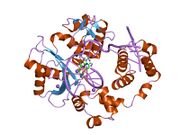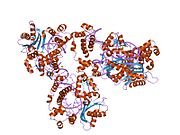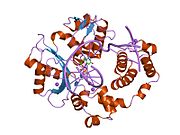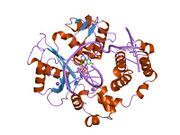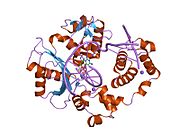Biology:DNA polymerase lambda
 Generic protein structure example |
DNA polymerase lambda, also known as Pol λ, is an enzyme found in all eukaryotes. In humans, it is encoded by the POLL gene.[1][2]
Function
Pol λ is a member of the X family of DNA polymerases. It is thought to resynthesize missing nucleotides during non-homologous end joining (NHEJ), a pathway of DNA double-strand break (DSB) repair.[3][4] NHEJ is the main pathway in higher eukaryotes for repair of DNA DSBs. Chromosomal DSBs are the most severe type of DNA damage. During NHEJ, duplexes generated by the alignment of broken DNA ends usually contain small gaps that need to be filled in by a DNA polymerase. DNA polymerase lambda can perform this function.[5]
The crystal structure of pol λ shows that, unlike the DNA polymerases that catalyze DNA replication, pol λ makes extensive contacts with the 5' phosphate of the downstream DNA strand. This allows the polymerase to stabilize the two ends of a double-strand break and explains how pol λ is uniquely suited for a role in non-homologous end joining.[6]
In addition to NHEJ, pol λ can also participate in base excision repair (BER), where it provides backup activity in the absence of Pol β.[7][8] BER is the major pathway for repair of small base damages resulting from alkylation, oxidation, depurination/depyrimidination, and deamination of DNA.
Besides its catalytic polymerase domain, pol λ has an 8 kDa domain and a BRCT domain. The 8 kDa domain has lyase activity that can remove a 5' deoxyribosephosphate group from the end of a strand break.[9] The BRCT domain is a phosphopeptide binding domain that is common among DNA repair proteins and is likely involved in coordinating protein-protein interactions.[10] Pol λ is structurally and functionally related to pol μ, another member of the X family that also participates in non-homologous end joining.[11] Like pol μ, pol λ participates in V(D)J recombination, the process by which B-cell and T-cell receptor diversity is generated in the vertebrate immune system. Whereas pol μ is important for heavy-chain rearrangements, pol λ seems to be more important for light-chain rearrangements.[12][13] The yeast Saccharomyces cerevisiae has a single homolog of both pol λ and pol μ called Pol4.[14]
Translesion synthesis is a damage tolerance mechanism in which specialized DNA polymerases substitute for replicative polymerases in copying across DNA damages during replication. DNA polymerase lambda appears to be involved in translesion synthesis of abasic sites and 8-oxodG damages.[5][15]
Interactions
Pol λ has been shown to interact with PCNA.[16]
References
- ↑ "Entrez Gene: POLL polymerase (DNA directed), lambda". https://www.ncbi.nlm.nih.gov/sites/entrez?Db=gene&Cmd=ShowDetailView&TermToSearch=27343.
- ↑ "Two novel human and mouse DNA polymerases of the polX family". Nucleic Acids Res. 28 (18): 3684–93. September 2000. doi:10.1093/nar/28.18.3684. PMID 10982892.
- ↑ "DNA joint dependence of pol X family polymerase action in nonhomologous end joining". J. Biol. Chem. 280 (32): 29030–7. August 2005. doi:10.1074/jbc.M505277200. PMID 15964833.
- ↑ "Implication of DNA polymerase lambda in alignment-based gap filling for nonhomologous DNA end joining in human nuclear extracts". J. Biol. Chem. 279 (1): 805–11. January 2004. doi:10.1074/jbc.M307913200. PMID 14561766.
- ↑ 5.0 5.1 "Structure-function studies of DNA polymerase λ". Biochemistry 53 (17): 2781–92. 2014. doi:10.1021/bi4017236. PMID 24716527.
- ↑ "A structural solution for the DNA polymerase lambda-dependent repair of DNA gaps with minimal homology". Mol. Cell 13 (4): 561–72. February 2004. doi:10.1016/S1097-2765(04)00061-9. PMID 14992725.
- ↑ "Interplay between DNA polymerases beta and lambda in repair of oxidation DNA damage in chicken DT40 cells". DNA Repair (Amst.) 6 (6): 869–75. June 2007. doi:10.1016/j.dnarep.2007.01.011. PMID 17363341.
- ↑ "DNA polymerase lambda mediates a back-up base excision repair activity in extracts of mouse embryonic fibroblasts". J. Biol. Chem. 280 (18): 18469–75. May 2005. doi:10.1074/jbc.M411864200. PMID 15749700.
- ↑ "Identification of an intrinsic 5'-deoxyribose-5-phosphate lyase activity in human DNA polymerase lambda: a possible role in base excision repair". J. Biol. Chem. 276 (37): 34659–63. September 2001. doi:10.1074/jbc.M106336200. PMID 11457865.
- ↑ "The BRCT domain is a phospho-protein binding domain". Science 302 (5645): 639–42. October 2003. doi:10.1126/science.1088753. PMID 14576433. Bibcode: 2003Sci...302..639Y.
- ↑ "Sibling rivalry: competition between Pol X family members in V(D)J recombination and general double strand break repair". Immunol. Rev. 200: 156–64. August 2004. doi:10.1111/j.0105-2896.2004.00160.x. PMID 15242403.
- ↑ "Immunoglobulin kappa light chain gene rearrangement is impaired in mice deficient for DNA polymerase mu". Immunity 19 (2): 203–11. August 2003. doi:10.1016/S1074-7613(03)00203-6. PMID 12932354.
- ↑ "Nonoverlapping functions of DNA polymerases mu, lambda, and terminal deoxynucleotidyltransferase during immunoglobulin V(D)J recombination in vivo". Immunity 25 (1): 31–41. July 2006. doi:10.1016/j.immuni.2006.04.013. PMID 16860755.
- ↑ "The polymerases for V(D)J recombination". Immunity 25 (1): 7–9. July 2006. doi:10.1016/j.immuni.2006.07.007. PMID 16860749.
- ↑ "A fidelity mechanism in DNA polymerase lambda promotes error-free bypass of 8-oxo-dG". EMBO J. 35 (18): 2045–59. 2016. doi:10.15252/embj.201694332. PMID 27481934.
- ↑ "Human DNA polymerase lambda functionally and physically interacts with proliferating cell nuclear antigen in normal and translesion DNA synthesis". J. Biol. Chem. 277 (50): 48434–40. December 2002. doi:10.1074/jbc.M206889200. PMID 12368291.
 |
